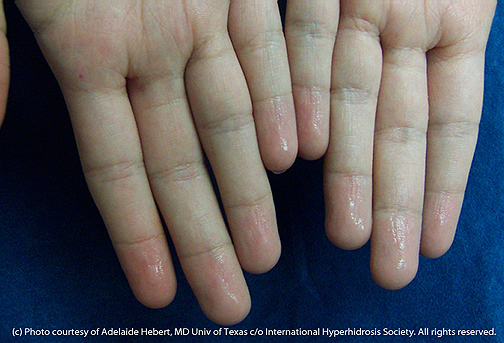Targeted Dermatology Treatments for Hyperhydrosis of Hands and Feet: Reliable Solutions
Targeted Dermatology Treatments for Hyperhydrosis of Hands and Feet: Reliable Solutions
Blog Article
Unveiling the Intricacies of Excessive Sweating: A Comprehensive Guide to Medical Diagnosis and Monitoring
Excessive sweating, medically known as hyperhidrosis, is a condition that impacts a significant number of people and can have an extensive effect on their lifestyle. While sweating is a natural physical function, its overactivity in hyperhidrosis presents a special set of difficulties that often surpass simple pain. Comprehending the underlying reasons, identifying the signs and symptoms, and navigating the diagnostic process for hyperhidrosis can be intricate tasks. In this detailed overview, we will discover the intricacies of hyperhidrosis, from its medical diagnosis to the array of treatment options offered, dropping light on efficient administration approaches for those coming to grips with this problem.

Understanding Hyperhidrosis Causes
Hyperhidrosis causes can be associated to different factors such as genetics, hormone discrepancies, and specific medical conditions. Genes play a substantial function in key focal hyperhidrosis, where people inherit the condition from their household members. By determining the specific factors adding to extreme sweating, health care carriers can tailor therapy plans to address the underlying reason, providing alleviation and enhancing the top quality of life for individuals affected by hyperhidrosis.
Acknowledging Hyperhidrosis Effects

In addition, hyperhidrosis signs might show up in emotional and social distress, as individuals may really feel ashamed or distressed regarding their sweating, bring about evasion of social scenarios (Exessive Sweating). Furthermore, duplicated episodes of excessive sweating can lead to skin maceration, fungal infections, and a total decrease in self-esteem
Diagnostic Refine for Hyperhidrosis
Starting the diagnostic process for extreme sweating entails comprehensive evaluation of the person's case history and checkup. Asking about the start, duration, and triggers of sweating episodes is important to differentiate between key focal hyperhidrosis and secondary generalised hyperhidrosis. Case history must also consist of inquiries concerning medicines, clinical conditions, and family history of hyperhidrosis.
During the health examination, certain focus is paid to the locations impacted by sweating. The health care service provider might examine the degree Our site of sweating, check for signs of underlying conditions, and evaluate the effect of sweating on the person's quality of life. Additionally, certain tests like the gravimetric test, starch-iodine examination, or skin conductance dimensions might be performed to measure the amount of sweat generated.
In addition, in cases where second hyperhidrosis is presumed, added examinations such as blood examinations, pee examinations, and imaging studies might be recommended to recognize the underlying source of extreme sweating. The diagnostic procedure aims to properly identify the type and source of hyperhidrosis to direct proper monitoring methods.
Treatment Options for Hyperhidrosis
When attending to extreme sweating, numerous therapy alternatives are available to minimize symptoms and enhance the person's lifestyle. The therapy technique for hyperhidrosis relies on the seriousness of signs and the client's response to preliminary treatments.
Topical therapies, such as aluminum-based antiperspirants, are commonly recommended as the initial line of protection for managing moderate situations of hyperhidrosis. These products function by connecting the sweat air ducts, thus minimizing the quantity of sweat that gets to the skin's surface. For individuals with a lot more severe signs and symptoms, dental medicines like anticholinergics may be suggested to assist decrease sweating. These medicines can have side results and are not ideal for every person.
Effective Administration Techniques
To effectively manage hyperhidrosis, a extensive and individualized therapy plan tailored to the person's specific requirements and feedback to previous therapies read this article is crucial. Iontophoresis, involving the use of a reduced electric current to decrease sweat gland task, can be beneficial for both palmoplantar and axillary hyperhidrosis. A multidisciplinary method including dermatologists, key treatment medical professionals, and, special info if required, specialists, can maximize the monitoring of hyperhidrosis.
Conclusion
Finally, hyperhidrosis is a problem identified by too much sweating, which can greatly impact an individual's top quality of life. By recognizing the causes, recognizing the symptoms, and undergoing the diagnostic process, doctor can successfully handle this problem. Therapy choices consist of topical drugs, dental medicines, shots, and even surgical procedures in serious situations. With appropriate diagnosis and administration techniques, individuals experiencing hyperhidrosis can discover relief and enhance their overall well-being.
Excessive sweating, medically recognized as hyperhidrosis, is a condition that affects a substantial number of people and can have a profound influence on their top quality of life. By determining the particular factors adding to too much sweating, health care carriers can customize treatment plans to resolve the underlying reason, providing alleviation and enhancing the high quality of life for people impacted by hyperhidrosis.
Hyperhidrosis, characterized by too much sweating beyond what is essential for managing body temperature, can considerably influence an individual's top quality of life. Asking about the start, duration, and causes of sweating episodes is vital to distinguish in between main focal hyperhidrosis and secondary generalized hyperhidrosis. Treatment for hyperhydrosis of hands.In verdict, hyperhidrosis is a condition defined by excessive sweating, which can greatly influence an individual's top quality of life
Report this page